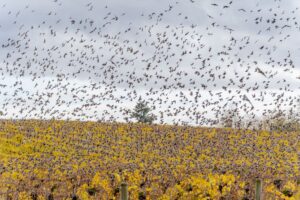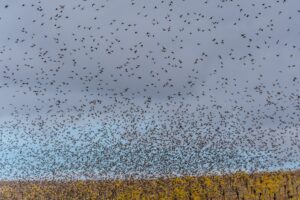
Murmurations are incredible activities of starlings who take to the skies. Unbeknownst to them, they are creating stunning displays of what can only be described as gorgeous sky art. There are natural science and laws of physics behind the practice of starlings as they fly and ably keep up with each other to deliver a cloud of birds moving in sync.
The pattern is a natural screen that allows starlings to watch out for birds of prey that would stalk them, and to keep eyes out for places to roost for the night. While this is a necessary practice for starlings, we on the viewer side, are often rewarded with the visual of typically hundreds of birds flying as what appears as a single entity.
Capturing Starlings’ Perfect Synchrony

Early in November 2024, photographer Brian Stone, who photographs homes and real estate as a vocation in Salem, Oregon, was delighted to witness a massive collection of starlings, literally thousands, in the sky performing the natural miracle of a murmuration. A quick look at Stone’s Facebook page, and it’s easy to see that he is a fan of birdwatching.
Stone caught sight of the formed mass of flocking birds as he drove near the Baskett Slough National Wildlife Refuge. Stopping to video the unusual grouping of many thousands of starlings as they began to close the night out with a ritual act of safety and search, he captured a delightful video, which was picked up by the local news organization The Oregonian for post.
This recent large murmuration is not unique to the photographer or the area. Other people near the Refuge have noted similar murmurations of starlings happening every evening during the fall, winter, and spring of each year.
Most of us have likely seen more than a few murmations in our lifetimes. Some are spectacular, while others are a small grouping of starlings. Nevertheless, any murmuration is marvelous to observe as you drive along roadways.
Murmurations underscore an impressive science of awareness as each bird must keep tabs on at least seven of their flying neighbors in the sky. This allows the birds to present a fearsome but effective display of a singular moving entity to deter preying raptors. There are other ideas in the science community as to why these murmurations occur: to become warmer by sharing body heat before settling for the night. Another thought is that starlings are inviting other starlings to join them as they begin to roost for the night. Regardless, the display is second to none with its beautiful appearance of concerted effort.
Murmurations generally occur an hour before sunset near where they roost for the night. They’ll perform this display for approximately 45 minutes before suddenly dropping into their selected place of rest.

When I originally commented I clicked the -Notify me when new comments are added- checkbox and now each time a comment is added I get four emails with the same comment. Is there any way you can remove me from that service? Thanks!
Howdy just wanted to give you a quick heads up and let you know a few of the pictures aren’t loading properly. I’m not sure why but I think its a linking issue. I’ve tried it in two different browsers and both show the same results.
You have brought up a very wonderful details , appreciate it for the post.
Valuable info. Fortunate mee I discovered your wbsite accidentally, aand I aam surprised why this accidednt ddid noot happenewd earlier!
I bokokmarked it.